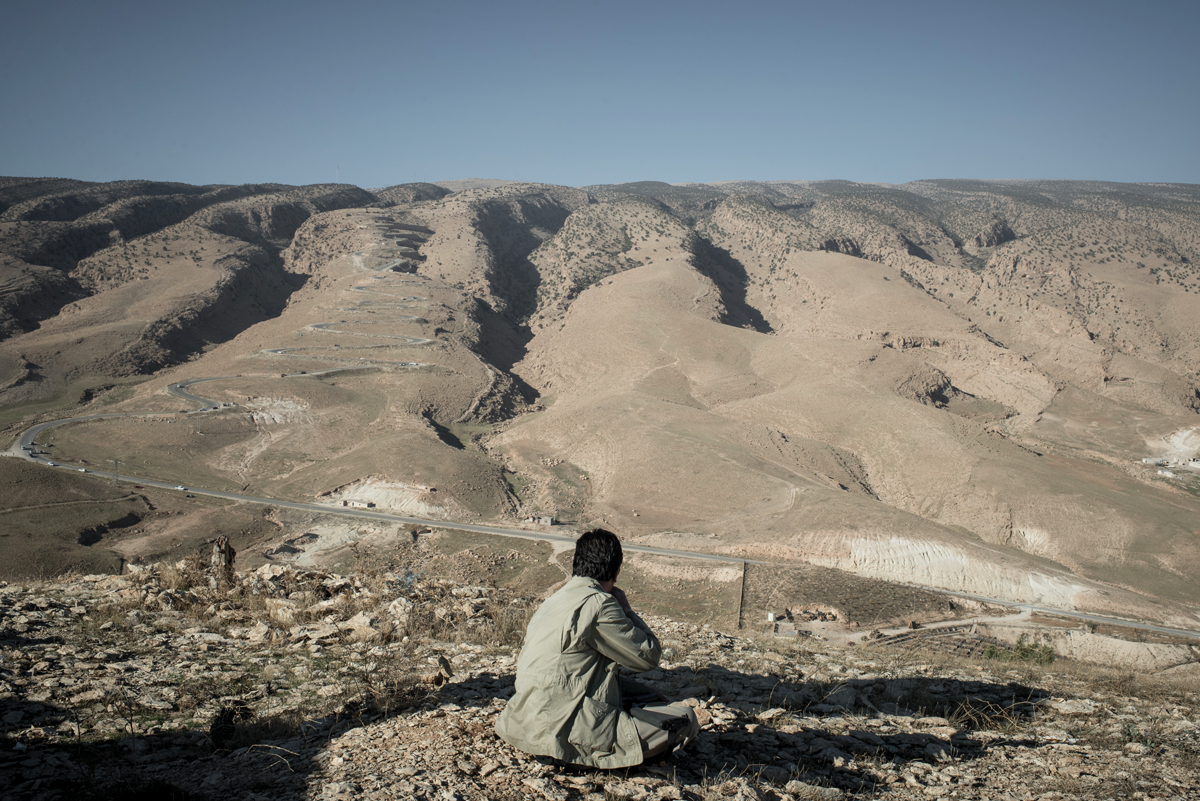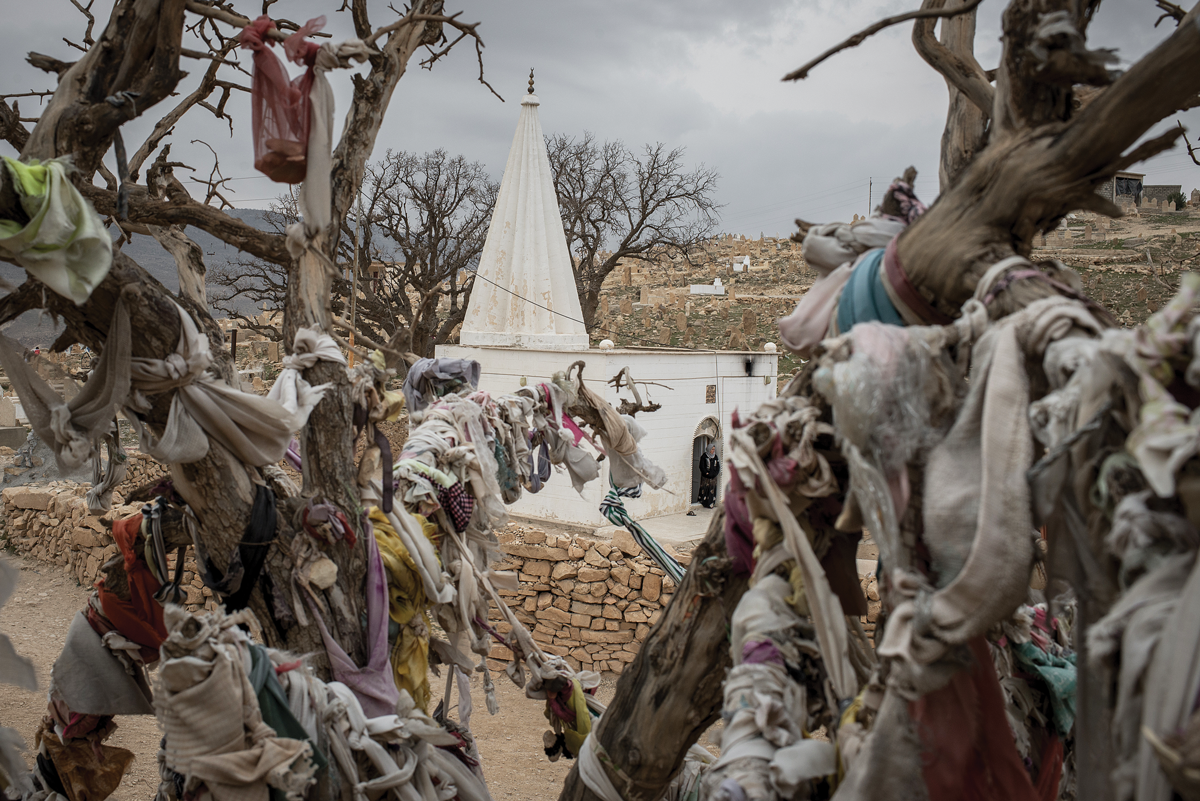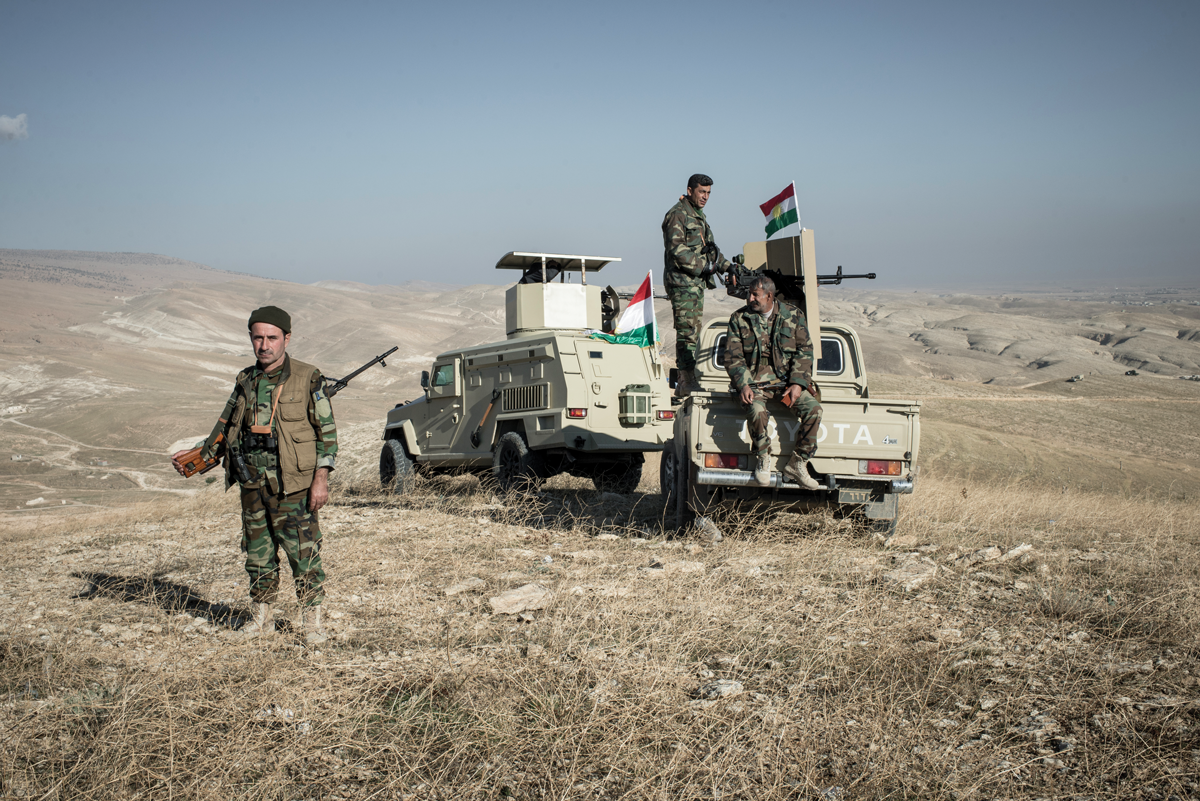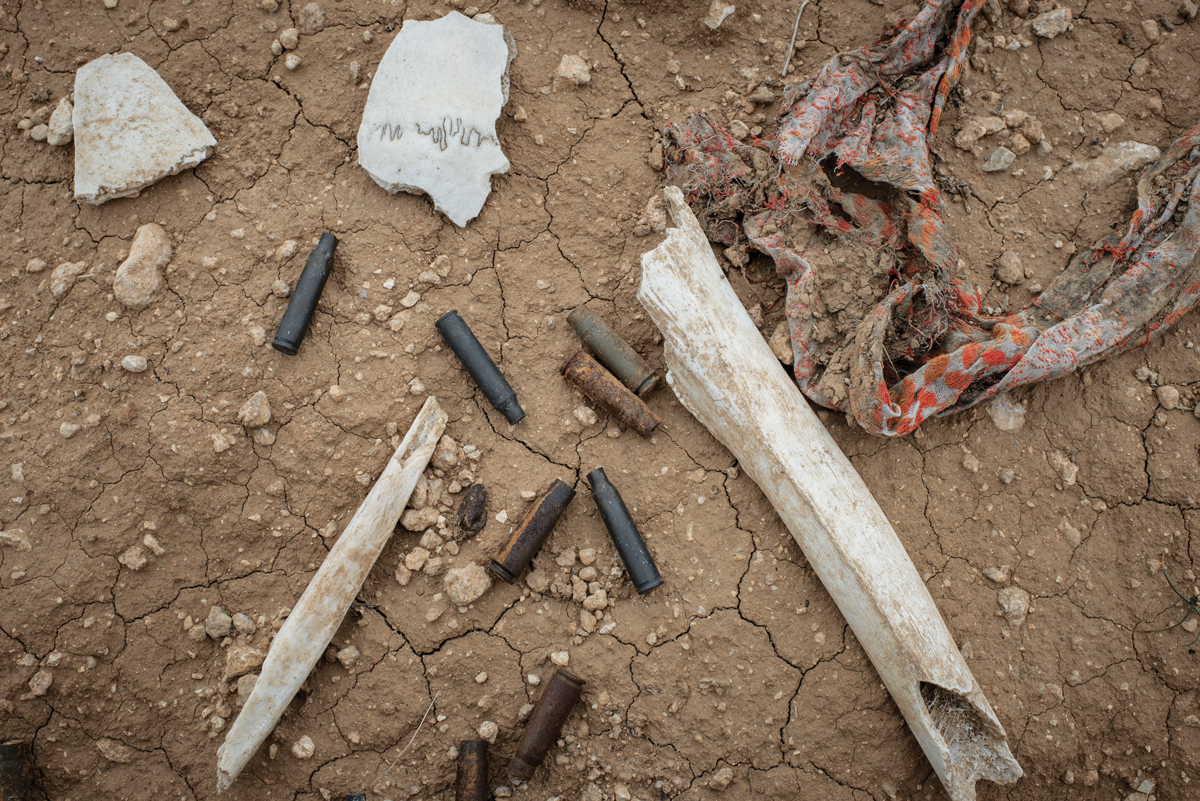Letter from Sinjar: Convert or Die
A city ravaged by ISIS is littered with explosives and mass graves
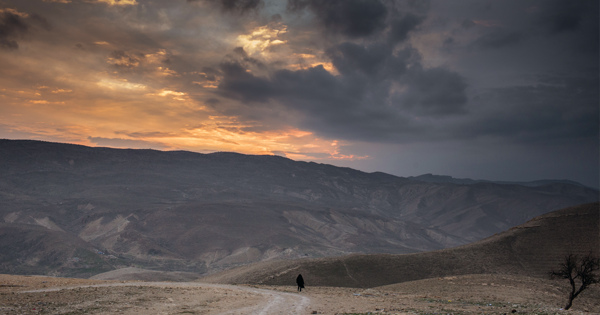
The bodies had been covered with dirt. Tracks from the killers’ trucks were still visible, but by now rain and animals had exposed some of the bones. A femur. A skull with a circular hole, half an inch wide. Also, a blue football shirt. Bullet casings.
ISIS fighters were not far away. I was examining the ground when I heard the suck and thud of another coalition airstrike. Above me, Sinjar Mountain was wrapped in a blue mist, and on the plain below there was a great cloud in the cold December sky. A flock of starlings burst into the air, startled by the concussions. I watched the patterns of the birds as they flew in formation and then settled on a power line by Highway 47, the road that used to connect the ISIS-held cities of Mosul, Iraq, to the east and Raqqa, Syria, to the west until Kurdish fighters retook Sinjar last November.
The road descending to the town of Sinjar is made up of dozens of switchbacks down the side of the mountain. Earlier in the day, my body had swayed with every turn. Outside the window, discarded clothes lay everywhere along the road, left by tens of thousands of displaced Yazidis as they fled their homes. Burned-out, rusted cars rested at strange angles on the hillside. The town and surrounding area were littered with explosives and mass graves. I got out of the car and walked the narrow streets. Houses had been reduced to concrete craters, and a water tower near an old Kurdish peshmerga position showed the pockmarks of bullet holes. Above the waves of rubble, a wooden cross marked the site of a destroyed church. Behind it, I came upon the corpse of an ISIS fighter, flesh hanging from his bones.
A month later, three hours to the northeast in the Kurdish city of Dohuk, I met with Captains Imad Ali Sado and Falah Hassan Jiyan of the Kurdistan regional police. Both men are Yazidis, followers of a minority religion centered in northern Iraq, which draws on ancient Iranian beliefs combined with elements of the Abrahamic faiths. Yazidis are monotheists, believe in reincarnation, and practice baptism rites. They worship an angel in the form of a peacock named Tawuse Melek, who for them represents God but whose story also resembles that of Satan in the Bible and the Koran, fueling the common mischaracterization of Yazidis as devil worshippers. ISIS regards them as infidels who must convert or be killed.
Sitting in Falah’s office smoking cigarettes and sipping tea, they told me of their work on behalf of the Commission for Recognition of Genocide Against the Yazidi Kurds and Other Ethnic Minorities. Behind Falah’s desk lay a stack of plain white folders, each one containing the testimony of a Yazidi survivor along with information on who from the family had been kidnapped, who was missing, and who had been killed. So far, the testimonies number in the hundreds. Falah brings survivors into his office to watch videos of ISIS massacres in the hope they can identify their loved ones. I watched two such videos with him. In one, half a dozen men lay face down in the hot sun, jerking as bullets sprayed into them.
Some of the 25 known mass gravesites have been exhumed, but the ones near Sinjar are still too close to the front lines, officials told me. In Dohuk, I also met with Hussein Kassim Hassoun, a special adviser to Iraqi Kurdistan’s prime minister and a member of the genocide commission, who stressed the importance of bringing in international forensics experts to help catalogue the remains for possible legal action. “It is very important to prove that the intent of this group was to destroy this community,” he said. After all, ISIS began executing people within an hour of taking the city. “That means you have been arranging this and preparing this and thinking about this.”
A 30-year-old day laborer named Sami Misho happened to be working in a factory on the other side of Sinjar Mountain when the rest of his family, residents of the nearby village of Kojo, found themselves surrounded by ISIS fighters. Later, having fled to Kurdistan, Sami told me what he knew of their fate.
After ISIS seized Sinjar on August 3, 2014, stories of the massacres there began filtering back to the trapped villagers in Kojo, making clear the futility of escape—ISIS fighters killed or kidnapped all those who attempted to flee Sinjar and nearby villages. “Whenever I talked to anyone there, even the men, they were crying,” Sami remembered. On August 15, he got a call from an Arab neighbor who said that an ISIS convoy was heading toward Kojo. Sami phoned his family. “I was talking to them at about 11:30 A.M.,” he said. “They told me they had to go because there was an ISIS car in front of the door.” At 1 P.M., he tried to call them back but couldn’t get through.
At the same time, Abu Ehsan, a 34-year-old Yazidi and Iraqi army veteran, was on his way to Kojo’s village school. Later, in a camp for displaced Yazidis outside Zakho, a border town nestled in the ring of mountains separating Iraq from Turkey, I spoke with Abu Ehsan and Sami about their escape from Kojo. As we talked and daylight faded, other Kojo survivors drifted in and sat with us. We drank small cups of bitter coffee as the men recounted their stories.
Upon his arrival at the village school in Kojo, Abu Ehsan saw that the whole town had gathered. ISIS fighters were forcing everyone into the building, collecting their cell phones as they entered. “One of the guys asked the Yazidi village chief why they were putting us in the school,” Abu Ehsan remembered. “ ‘I am not sure,’ the chief answered. ‘Either they are going to kill us or take our money and things from us.’ ” The chief told the villagers to give ISIS everything they had. “You don’t want to be hurt just because you kept some money or gold in your pocket.”
The fighters separated the women and children from the men, and drove them north to Sinjar’s technical institute, adjacent to a farmer’s dry pond. From there, as later became clear, the younger women were sent to ISIS strongholds to be enslaved and raped. Meanwhile, the Yazidi men were taken south. “They brought our cars to the doors and took the men in groups of 10 or 15,” said Abu Ehsan, who was in the second group. “We thought we were going toward the mountain, but we found we were going farther south. Next to the town, there is a farm and a big ditch. When we got out of the car, we saw 20 fighters with their faces covered and holding AK-47s. We saw them loading their weapons.”
The older Yazidi men in the group encouraged the younger men to say their final words: a declaration of faith to Tawuse Melek, the Yazidi peacock angel. Then the fighters lined them up at the edge of the ditch and told them to turn around. Hearing the order to fire, Abu Ehsan threw himself to the ground and managed to hide under the body of the man next to him.
When the firing stopped, three or four fighters picked through the bodies, shooting anyone still alive. Abu Ehsan heard them talking to each other between shots. Nearby, a man was moaning in agony. “I kept telling him, don’t make noises, don’t make sounds, there is a guard watching us from that house.” But the guard heard and returned to shoot Abu Ehsan in the back. “After the ISIS guys left, I called out to everyone in the group and asked, ‘Is anyone still alive?’ ” Seeing no one around, Abu Ehsan got up and tried to run, only to collapse in pain. “I was on the ground, and it was so hot my hand was burned. I was playing dead.”
After hiding for a while behind an earth berm, he broke into a farmhouse in search of water. He drank and passed out. “When I woke up, it was dark. Then I saw there was blood everywhere, I saw it on my hands.” He wrapped a headscarf around his bullet wound. “I saw the mountain and went toward it.” On his way, he met two other survivors. Together they crossed the ISIS frontier and made it to the Yazidi villages on the mountain. Today, he estimates that as many as 370 men were killed by ISIS in the village of Kojo alone. The village itself remains under ISIS control, the bodies of the men shot alongside Abu Ehsan yet to be found.
Collecting the necessary documentation to bring a genocide case will take years, and many obstacles will need to be overcome before justice can be served—not least of which that the International Criminal Court has no jurisdiction in Iraq. The act of pursuing a case, however, may yield less tangible but still important benefits, such as recording what happened to the Yazidis of Sinjar both during and after the massacre and perhaps furthering the difficult task of reconciling former friends and neighbors in communities where the killings and abductions took place.
Today, Sinjar Mountain is home to more than 1,000 displaced families, most of them living in tents with little outside help. The bare mountainside is dotted with shrines and mausoleums to Yazidi saints, where worshippers still light candles and make wishes, kiss the walls of the mausoleums, and look out over the destroyed towns below. But most of the hundreds of thousands of Yazidis who once lived in the area now inhabit sprawling tent cities on the outskirts of larger urban areas to the north. For them, the price of Sinjar’s liberation was Sinjar itself.
Kurdish peshmerga fighters pushed ISIS south of Highway 47 last November, but many Yazidi towns remain under its control. Even in recently liberated towns and villages, most displaced Yazidis are refusing to return, citing the alleged collaboration of their Muslim neighbors with ISIS and the continuing threat the group poses. Some Yazidi leaders have even called for UN protection to facilitate the safe return of displaced communities.
Sami Misho, the laborer from Kojo, feels there’s nothing left for him in Iraq and plans to follow the smuggling routes to Germany. He hasn’t heard from any members of his extended family since the day the ISIS car pulled up to their house in Kojo, and he suspects they are buried with the other victims of the massacre. As for his wife and two young children, he believes they were abducted by ISIS and subsequently killed in an airstrike targeting the group in Raqqa. In Zakho, Sami showed me a photograph taken in a happier time: his 65-year-old mother, Noora Ismail, stands under a blue sky in a meadow filled with yellow flowers, wearing an orange-and-white fabric belt around her waist and a white scarf wrapped loosely around her head. Behind her looms the low, purple ridge of Sinjar Mountain.
The photograph made me think back to the mass grave near Sinjar. I had returned to the site only the day before. In the distance, I could see the village of Tal Qasab, still held by ISIS, and hear the occasional exchange of fire. The sky was blue but the pond still dry. Human remains littered its bed. Among the bones were scattered the long fabric belts typically worn by older Yazidi women. One of them was orange and white, like the sash that Noora Ismail had worn in her photograph.

